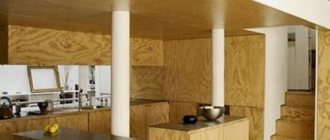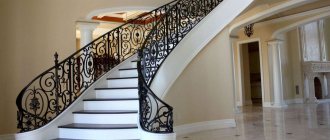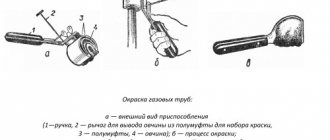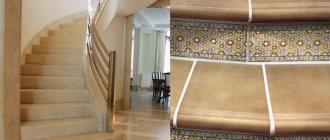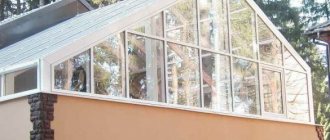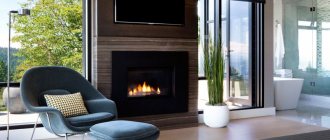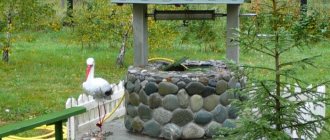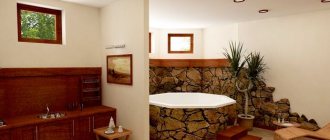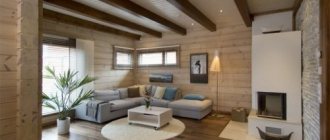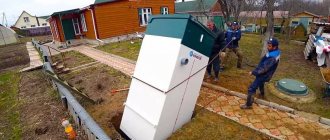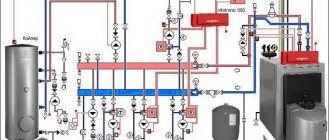Many private house projects include a veranda. It can be either built-in (constructed during the construction of the house) or attached (usually it is done when the house is already built). The veranda is an important part of the house, where people often set up a recreation room, grow plants, and make a workshop.
In this article we will look at what main functions this extension performs, what materials are best to make it from, and how to properly equip and decorate it.
Why is a veranda needed and what are its functions?
The veranda is a small room attached to one of the walls of the house, and is intended for organizing summer recreation. Depending on the type of construction, it can be open or closed. Although most often, people build summer outdoor areas with a canopy and railings.
The main functions that this structure performs include:
- additional insulation of the house;
- protecting the front door from drafts;
- protecting the house from intruders (if we are talking about a closed building);
- increasing sound insulation in residential premises;
- availability of additional space for organizing a recreation area.
Decorating the veranda with wood
Wood has always been considered the best material for any finishing work inside the veranda. The easiest way is to cover the walls inside the room with clapboard, both in an expensive version and relatively inexpensively, approximately at the level of PVC panels.
Standard lining is divided into four quality classes:
In addition to class, the material may differ in the shape of the front surface. Examples of the most popular profiles are shown in the figure. If you want to create the impression of a log vault and walls, you can sheathe the walls inside the room with one of the types of boards - block house.
The technology of clapboard cladding is practically no different from the technique used for installing PVC. Initially, the starting strip is laid, and then the lining boards are laid on the previously filled sheathing. It is best to sheathe the walls of the veranda using staples, without glue or screws.
Larch is the most difficult to install, but it's worth it. Even for the most comfortable veranda there is no point in purchasing cedar or ash if you need to sheathe the room quickly and inexpensively. The best option would be high-quality spruce or pine, which can be ordered inexpensively from a private carpentry shop, dried, polished the front part and coated with wax.
Even an open or unheated veranda can be covered with such cladding. A pleasant bonus will be the smell of pine forest, which appears when the walls of the veranda are heated by the sun's rays.
How to arrange a veranda: choosing a style
Usually, the veranda is made in a rustic style and is completely lined with wood. Although some owners of private houses prefer other stylistic directions:
- hi-tech . Modern furniture with chrome elements is installed here, household appliances are placed (if the room is closed), roller blinds or roller blinds are hung on the windows instead of curtains;
- modern _ It implies the use of both classic and modern furniture items, decors and other things;
- minimalism. Here preference is given to monochrome tones, straight lines and a minimal amount of furniture;
- baroque. It implies an abundance of luxurious and pompous accessories, the use of expensive finishing materials;
- Mediterranean. When decorating the interior, preference is given to marine shades and prints, as well as wicker furniture.
Which style to choose, each home owner decides for himself, based on the landscape design, the general architecture of the building, his financial capabilities and personal wishes.
Attention : when choosing a color scheme for decorating a recreation area, you should pay attention to which side of the house it is attached to. If it is the south side, preference is given to cool colors, and if it is north - warm.
Plastic
Plastic decorative finishing of a dacha veranda, repair and finishing work on which is limited to a small budget, is an option that can be called “cheap and cheerful”. A large selection of colors and patterns of plastic for outdoor use allows you to create an imitation of wood, timber, or stone. To decorate a veranda or terrace the following are used:
- Facade panels - PVC panels for cladding external walls.
- Siding - plastic boards with tongue-and-groove fastening.
Advantages of plastic
- resistance to temperature changes;
- ease of installation and maintenance;
- good sound insulation;
- large selection of colors;
- low price.
Flaws
- fades in the sun;
- may release toxins when heated;
- low vapor permeability - the walls do not “breathe”;
- service life - no more than 10 years.
Cost of plastic finishing: from 250 rubles per 1 sq. meter.
General requirements for materials
Decorating a veranda in a private house, inside and outside, involves the use of high-quality and proven materials. When choosing them, you should consider the following:
- resistance to sudden temperature changes. At the same time, attention is paid to which side the building is located on (sunny or northern), whether it is heated or not;
- humidity inside. Depending on it, the room can be sheathed with plastic or materials based on cellulose fibers;
- how long ago the building was built. If less than a year has passed (provided that the extension is wooden), then the process of shrinkage of the building has not yet ended. Therefore, you should not choose too expensive materials, or even better, wait a little before starting repairs.
Columnar foundation
Pillars are more expensive than a gravel-sand foundation, but they also last much longer. The classic version of supports is reinforced concrete piles. They are strong, reliable and stable, but they are rarely made today. The reason is the excessive labor intensity and duration of the process.
It is much easier and faster to install a terrace on screw piles. These are hollow metal cylinders equipped with a blade. They are simply screwed into the ground and then filled with concrete. Typically, such work takes no more than two working days.
It is worth noting that ease of installation is not the only advantage of screw piles. They can be screwed in to different depths, bringing the tops to the same level. This helps solve problems with uneven terrain of the site.
The step between columnar supports should not exceed 2 m. If this rule is neglected, the flooring boards will inevitably bend
The final stage of creating a columnar foundation is creating a frame on which the logs will lie. The material for it, as a rule, is metal pipes with a cross-section of 80×80 mm. The cell size is 80x80 cm. An alternative option is 50x100 mm timber. In this case, the cell should be smaller - 50x50 cm.
Important!
The wooden frame must be thoroughly impregnated with antiseptics or covered with protective paint, otherwise the structure will not last long.
Rating of finishing materials for the veranda
Studying the TOP of the best finishing materials used when covering the terrace, it is worth highlighting the following:
- MDF panels . Their composition is dominated by wood particles, therefore they are environmentally friendly and safe. But this material is suitable only for the interior design of closed premises;
- Plastic. It is used for cladding open verandas, as it perfectly withstands moisture, sudden temperature changes and is resistant to mechanical damage.
- Tree . This can be either edged boards, lining, OSB boards, etc. Each individual option has its own advantages and disadvantages.
- DSP . This option is the most budget-friendly and quite acceptable. Cement particle boards are not afraid of moisture, have an aesthetic appearance and are inexpensive.
Screed
The most reliable and durable foundation for a terrace is a reinforced cement screed 70-100 mm thick, poured over a gravel-sand cushion. Such a foundation will serve for decades. To avoid the logs getting wet, they can be laid on rubber pads. They will allow you to create a gap of about 5 mm, sufficient for water drainage. However, there is a better option - adjustable screw supports that will raise the logs to the desired height and allow you to install them absolutely horizontally
Improvement of ceilings
Since the ceiling surface bears quite heavy loads, reliable materials are selected for its construction. They must be: durable, light in weight and moisture resistant. From the above requirements, it is worth highlighting the following materials suitable for the ceiling - wicker and polycarbonate. They not only look aesthetically pleasing, but are also easy to install and do not require special maintenance.
When choosing polycarbonate, it is worth considering that it can be monolithic or cellular, transparent or colored. The weaving has an original appearance. For its arrangement, veneer or thin moisture-resistant plywood is used.
Gravel-sand cushion
The simplest, fastest and, most importantly, cheapest foundation is a cushion of sand and crushed stone. To create such a foundation, you need to remove the soil over the entire area of the future terrace to a depth of about 30 cm. The bottom of the resulting pit is covered with a drainage membrane (with an overlap of about 10 cm). It will serve for drainage.
The next stage of work is filling in a 10-15 cm layer of clean coarse sand. It is spilled with water and compacted thoroughly (it is advisable to use a vibrating plate). Next comes a cushion of fine crushed stone or gravel 10-15 cm thick, and this should also be compacted.
Paving slabs are placed on the compacted gravel, which will serve as a support for the logs, and the surface is leveled, filling the gaps between the squares with gravel.
This simple technology does not require either expensive materials or highly qualified craftsmen. A team of two people can complete the job in a couple of days. It would seem, why want more? But experts consider the gravel-sand cushion to be “a thing of the past”
, and there are reasons for this.
Firstly, rainwater inevitably collects in the pit. As a result, the soil will sag, which will inevitably lead to warping of the flooring. To avoid this, it will be necessary to lay drainage pipes, which means saving on the foundation will lose its meaning.
Secondly, the decking is subject to an uneven load. Due to the fact that one area is constantly walked on, and garden furniture is placed on another, the joists begin to move apart, and this also leads to warping of the flooring.
To prevent the tiles on the bulk foundation from creeping, the logs must be attached to them using clamps made of perforated metal tape and dowels
So, a gravel-sand cushion is a rather risky foundation for a terrace. Theoretically, such a foundation can serve for years, but the likelihood that it will “float” after a couple of rainy seasons is quite high.
Veranda flooring
So, how to decorate a veranda so that it is practical, aesthetic and easy to use? For finishing floors the following are used:
- terrace board;
- porcelain stoneware;
- rubber;
- linoleum;
- cement.
When choosing materials, it is worth considering the following: will the room be heated during the cold season, will you walk on the floors barefoot, in street shoes or in house slippers.
Important: in a closed and heated veranda, you can lay a carpet on the flooring.
Brick and stone
For houses lined with brick or stone, this option is the most suitable. External wall cladding is carried out using ventilated facade technology (SP 70.13330.2012). As a rule, insulation is provided in this case, allowing the country veranda to be used all year round. For finishing the following are used:
- Facing decorative brick.
- Artificial stone: agglomerate, porcelain stoneware, colored concrete.
- Natural stone: granite, travertine, basalt.
Advantages of finishing from natural or artificial stone
- high strength, resistance to damage;
- excellent sound insulation;
- fire and environmental safety;
- attractive appearance;
- does not require maintenance;
- service life - up to 100-150 years.
Flaws
- complexity of facing work;
- high price of material.
Sergey Yurievich
Construction of houses, extensions, terraces and verandas.
Ask a Question
Cost of external stone finishing: from 2500 rubles per 1 sq. meter.
How to decorate the walls on the veranda inside
Decorating a veranda in a private house involves the use of all kinds of materials. For interior wall decoration, home owners use:
- clapboard _ It can be placed in both vertical and horizontal positions. It is better to choose a lining with a thickness of 5-10 mm. It can be made of either wood or plastic;
- decorative plaster. This could be plaster that imitates natural stone, or Venetian plaster that replicates the texture of marble. Colors are added to the plaster to give the walls the desired color;
- MDF or PVC panels. They withstand temperature changes, are distinguished by high sound absorption rates, and are convenient to use.
Attention : a clapboard veranda is a classic option.
Variety of wood cladding
Modern manufacturers offer a large number of wood materials for decking. These are different types of raw materials: coniferous and hardwood.
Various methods of processing and designing wood produce finished products: timber, deck boards, lining, Block House, planken, decking (terrace board), thermopine.
Important! Each of the products is used for covering certain surfaces of the terrace. Some are suitable for walls and ceilings, some are ideal for flooring.
- To finish the terrace, it is more convenient to use imitation timber , since the material is made much thinner than timber intended for the construction of a log house or frame construction. Externally, a complete association with timber construction is created. Used for external and internal cladding of terraces.
- Deck boards are a classic option for wooden flooring. They are processed in such a way as to ensure the material is resistant to humidity and seasonal temperature changes. For finishing the terrace - one of the most suitable options.
- Lining is one of the most affordable and well-known materials. It is made with special grooves on the side edges, which simplifies its installation and joining. The veranda is completely sheathed inside, excluding only the floors. It is also suitable for exterior decoration. It must be taken into account that the grooves allow water to linger, which leads to warping of the elements.
- The Block House will create a complete imitation of a log building. This solution is used for facade cladding. Sometimes Block House is used in the interior decoration of terrace walls.
- Planken is an innovative wood material. The boards are installed overlapping, thanks to the beveled edges. This connection creates a reliable wall covering. Water simply flows over a flat surface without getting stuck in tight seams. It is beneficial to use planken in the exterior decoration of closed verandas and inside open terraces. The service life of planken is significantly higher than that of lining.
- Terrace boards or decking are produced using a special technology. During the heat treatment process, excess moisture is removed from solid wood. The result is a board that retains its original characteristics under external influences of water, ultraviolet radiation, low and high temperatures. The terrace board can be laid not only on the floor of the veranda, but it can also be used to pave garden paths. During operation, you can do without additional coatings with paints and varnishes; the products will not change their characteristics.
- Thermal treatment of pine with steam, at temperatures above its combustion, rids the wood of resin. As a result, the soft rock acquires unique strength and hardness. Thermal pine can also be used as a floorboard, unlike products made from conventional solid wood.
How can you sheathe the outside of a veranda?
When choosing what to cover the outside of an extension with, it is worth considering that the materials must be durable, practical, attractive and resistant to negative environmental factors. For these purposes it is best to use:
- polycarbonate This is a completely inexpensive material for which there is no need to create a capital foundation (due to its light weight). Its advantages include: high thermal insulation qualities, interesting design, creation of a favorable indoor microclimate, resistance to moisture, direct sunlight, long service life;
- tree . Despite the fact that it requires careful care, the natural texture of the wood looks very noble and attractive. The advantages of external cladding of the veranda with wood include: the ability to implement the project in any style, environmental friendliness, affordable cost;
- brick . It is distinguished by high levels of strength, reliability and durability. Such a structure will be warm, resistant to negative factors, and attractive. Not the entire extension can be finished with brick, but only the foundation and a few pillars. Decorating the pillars of the veranda with brick looks very noble and elegant;
- metal _ Requires additional insulation, since due to sudden temperature changes, condensation can accumulate inside the room during the cold season. This is a fairly budget option, which is most often used by summer residents;
- plastic _ Completely unpretentious in maintenance, easy to install, not exposed to atmospheric agents, and capable of withstanding heavy loads.
Tree species suitable for arranging verandas
Wood of any species has a number of common qualities for which the natural material is valued and has not lost its popularity over the centuries:
- environmentally friendly, surrounded by natural finishes it is easy to breathe, it is recommended for people with breathing problems and allergies;
- the unique pattern of wood, which is often preserved by covering the surface of wooden products with transparent varnishes;
- respond well to artificial aging techniques;
- coniferous species emit phytoncides, which are known
medicinal properties.
The cost of wooden products is determined based on the quality of the source material. The products are made from processed edged boards. The following types of wood are distinguished:
- class A - one knot is allowed within 1.5 m in length and up to 2 through cracks;
- class B - up to 4 knots and no more than 2 through cracks are allowed per 1.5 m;
- class C - the number of knots and through cracks is not regulated here; the maximum knot diameter is stipulated at 25 mm.
Important! When choosing boards or other wood products for finishing a terrace, you should be guided by the natural characteristics that a particular species has.
The most common types of wood are:
- Pine is one of the softest and cheapest coniferous species. Works well, easy to glue. The main disadvantage is its short service life, about 10 years.
- Larch is more expensive than pine. It has high levels of hardness, moisture resistance, and is practically not subject to warping. The service life of hardwood materials reaches 100 years.
- Cedar is a soft coniferous species. It is resistant to rot and wormholes. Great for carving. Cedar will last up to 20 years. At the same time, the price is accessible to a wide range of consumers.
- Oak is a deciduous tree, a record holder for lifespan in nature and in products, and will delight more than one generation - more than 100 years. It does not rot, resists insects well, and has the highest hardness.
Despite the viscosity of wood, oak is used for carving. Balusters and fencing posts will become a real decoration of the terrace.
Special processing methods significantly improve the natural characteristics of wood and make the natural pattern more vibrant. At the same time, the price of finished materials is rising. But during operation, owners can evaluate the benefits of investing in more technologically advanced products.
Interior decoration ideas
When deciding how to finish a terrace, it is worth considering its type of construction and other factors. It is worth noting that this room can be stylized in any direction. It can be decorated with original furniture, textiles, evergreen seedlings, and stone. In other words, it all depends on the personal wishes, preferences and financial capabilities of the residents.
Weaving
A wicker ceiling is a beautiful element of landscape design that is equally suitable for stone, wooden, and frame houses. There are two options for a wicker ceiling: a cheap one - from sheets of moisture-resistant plywood and an expensive one - from bamboo strips. In the first case, the ceiling is inexpensive, and installation is quick: plywood is cut into strips that are intertwined. Bamboo weaving sheets are sold ready-made. After purchase, they are simply woven together using the existing overlaps and the pre-prepared sheathing is covered with the resulting material.
Advantages of a wicker ceiling
- aesthetics, attractive appearance;
- ease of installation.
Flaws
- fire hazard;
- soaking due to precipitation;
- requires a sheathing device.
The cost of weaving from plywood is from 150 rubles per 1 sq. meter, made of bamboo - from 1200 rubles per 1 sq. meter.
Furniture for the veranda
When choosing furniture items for a terrace, it is worth considering the type of construction. If the room is open and unheated, products made of plastic, rattan, wood, and metal are suitable. They cope well with various negative factors. The main thing is to choose high quality products.
Wicker furniture items are suitable for buildings made of brick, siding panels or wood. With their help, a comfortable relaxation area is organized where you can have family conversations, drink tea with friends and simply relax in the fresh air.
Wooden tables and chairs please:
- aesthetics;
- durability;
- variety of designs.
But finishing the terrace with wood requires careful maintenance. To prevent rotting, items will need to be periodically treated with antiseptics.
Attention : when choosing outdoor wooden furniture, pay attention to the quality of its fittings and guides.
Metal objects heat up under the sun, fade, and corrode. However, they are affordable and resistant to chemical cleaning agents. Plastic is lightweight, compact in size, and presentable in appearance. Such furniture is completely unpretentious in maintenance and is distinguished by a variety of designs and color schemes.
Proper care will extend the life of wooden elements
Wood raw materials in their original form are not used in products or as finishing. Before making materials from natural material, it is subjected to chamber drying, removing excess moisture.
Often at the production stage, products are treated with special antiseptic and fire retardant compounds. These products give wood additional qualities or enhance existing natural characteristics:
- rot resistance;
- fire resistance;
- resistance to mold and mildew;
- resistance to insects and small rodents.
Immediately after finishing work, wooden elements are coated with protective varnishes, oils, and other compounds. During operation, it is necessary to regularly maintain the integrity of the outer layer of finishing. The need for constant maintenance is due to the fact that the terrace is exposed to weather factors all year round.
Premium class finishing compounds make it possible to carry out repairs not every year, but at the frequency suggested by the manufacturer. Protective agents not only protect wood from external factors, but also give surfaces decorative qualities. Some compounds tint wood trim, while others only tint slightly.
With the help of simple regular measures, a decent appearance of the wooden finishing of the terrace is ensured. You can also achieve an extension of the service life of wood.
Almost all wood products are repairable. This means that the failure of one element does not lead to the disassembly of the entire coating; it is enough to replace only the damaged product. The exception is lining.
It is worth noting that wooden finishing is good in mono design. But the combination of wood with other natural and artificial materials is wonderful: stone, glass, metal, plastic, ceramics.
Plants for the veranda
Living plants can not only decorate any interior, but also create the most comfortable atmosphere of warmth and coziness. They can be planted in pots, allowed to climb along poles, or placed in vases. To decorate the terrace from the street, plants such as crocuses, scillas, tulips, daffodils, and irises are used. For lovers of shrubs, it is worth choosing: rhododendrons, lilacs, spirea.
Attention: fuchsia and petunia hung in flowerpots near the house look very beautiful and original.
For extensions located on the north side, flowers such as heucheras, ferns, and jasmine are chosen. And for terraces located on the south side, roses, peonies, lilies are suitable.
Design styles
Each owner decorates the extension to the house according to his own taste. Here are examples of the most popular finishing styles.
Provence
The style comes from the southern coast of France. The veranda is decorated in light, discreet colors.
The characteristic finishing material is board, lining, painted white. The coating is aged artificially. Furniture is given a scuffed, rough appearance. The decor should create the impression that there are old parts around, faded with time.
The presence of fresh or dried flowers in vases and on the walls is welcome. Wicker chairs, armchairs, and tables will fit into the style.
The fencing of an open veranda with railings is best made of wood.
Loft
The loft style comes from the premises of old factories, production workshops, and warehouses.
Simplicity of details, absence of any intricate decorative details, strictness of colors are the main features of the loft.
The veranda must be visually made high. Large windows or panoramic glazing to the floor will help with this.
There should be maximum free space in the room. There are no restrictions in the choice of materials. But the decoration and furniture should be simple, close to production conditions.
For example, don't try to hide ventilation pipes or ceiling beams. Such accents just belong to the loft.
Chalet
Chalet-style buildings are called hunting lodges.
Character traits:
- low ceilings;
- stone floor;
- wooden walls;
- heavy furniture with rough finish;
- only natural textiles (bedspreads, rugs, runners).
There is always room for live plants in pots on the chalet-style terrace. The walls are decorated with hunting trophies and interesting imitation of them.
Decor items
Decorative items on the terrace can include:
- finishing materials for walls, floors and ceilings;
- textile;
- furniture items;
- dishes;
- paintings.
When choosing curtains, attention is paid to their functionality and practicality, and then to their appearance. For northern buildings, light organza fabrics are chosen; for southern buildings, they are denser and more opaque.
Lighting is also an important decorative element. When choosing lamps, preference is given to: floor, wall, ceiling sconces and chandeliers.
In conclusion, it is worth noting that we looked at how to cover a veranda at the dacha, what shrubs and flowers are best to plant near it, what style to decorate it in, how to choose the right furniture, and so on. By showing maximum imagination and creativity, owners of country houses can build a comfortable and stylish terrace where it will be pleasant to spend leisure time with family and friends.
Exterior cladding materials
Thinking about how to cover the outside of the veranda is always associated with the desire to create a complete image of the house and its extension. Therefore, most often they choose the same materials with which the facade is finished, or those that are similar in appearance to it. For example, if a house is built from rounded logs, it would be logical to line the frame veranda from the outside with a wooden or metal block house. And if it is covered with siding, the extension is also finished with the same material.
But this is not a rule, but rather the result of the practical thinking of most homeowners. Architects and designers often offer more interesting solutions, creating a single ensemble from seemingly incompatible materials.
This extension fits perfectly into the landscape of the site with stone paths and retaining walls
If you are deciding how to cover the outside of the veranda cheaply and beautifully, you can return to already known materials - wooden lining and siding.
It is important! Having chosen horizontal cladding, it is necessary to place the lining boards with the grooves down so that water does not flow into them.
If you are not too limited in funds, you can choose a more expensive, practical and durable option for plank wood trim. These are not tongue-and-groove boards made of larch, ash, cedar and other types of wood that are resistant to rotting. They are not mounted end-to-end, but with a small gap between the planks, which avoids their deformation when exposed to moisture.
Planken is suitable for both external and internal cladding of verandas
Planken comes with straight or beveled edges, with a smooth or grooved surface, untreated or factory-painted. Some manufacturers impregnate products with antiseptic compounds under pressure, which significantly increases their service life, and also complete them with a frame system and fasteners.
Advice! When purchasing untreated plank, it is impregnated with special synthetic compounds or linseed oil before installation.
A separate question is how to sheathe the outside of the veranda between the ground level and the walls if it stands on a screw or columnar foundation. There can be many options, from brickwork to cladding the frame with any suitable material:
